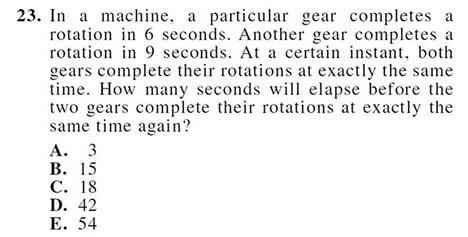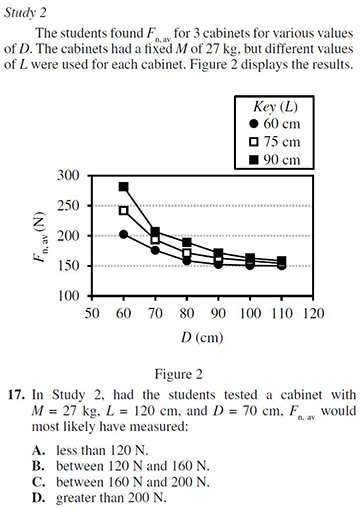…that your students should be getting right
Last week we examined two commonly missed skills in English and Reading. This week, let’s dig into content students struggle with on the Math and Science section of the ACT.
Math: Factors
The ACT Math test is really clever at assessing standards in an atypical way. In fact, most of the simpler math concepts are often hidden behind complicated and creative word problems. This crops up on the factors standard family, a commonly missed set of questions.
For example, some questions will overtly assess the definition of Least Common Multiple. Other questions, though, hide that definition inside of a word problem.
Example:

This question is really asking “what is the least common multiple of both 6 and 9?” If a student can see that right off the bat, then the correct answer is easy to come by – in this case 18. However, if the student can’t see this, he or she is stuck having to draw out a list of multiples of 6 and 9 until the two lists overlap.
Specifically, work with your students to identify unusual instances of factors and multiples. Use real or practice ACT questions. Remember, when your school purchases an ACT Boot Camp, you’ll get free access to our bell ringer content, which includes a section specifically focused on ACT factors questions.
When it comes to word problems in general, have students practice sifting through the scenario described to simply determine what math operation or concept is being tested. As soon as they can determine what’s being asked, they’ll often recognize they know the simple math required to solve the problem. This is both empowering and saves time, two factors that make a big difference on standardized tests.
Science: Predictions and Further Experiments
Making predictions is one of the most comment types of questions on the ACT Science test. It is also one of the most commonly missed. There are two reasons why students will struggle with this question type. First, many students simply go too fast and don’t process the information carefully. They might accidentally move the trend in the opposite direction or just misread the numbers. Second, a lot of student freeze when the information asked for in the question isn’t directly in the figure and a prediction is required.
The good news is, in either case, this is a question type that can be solved by pretty much any student, as long they have a good strategy.
When answering questions like this, students can use the following steps:
- Determine whether you can find the answer explicitly or need to draw a conclusion or prediction.
- If you’re making a prediction, follow the road signs in the question. Is a specific study or valued referred to? If so, look for it in the passage or figures.
- Identify any trends. Is one value increasing as another decreases? How do two lines or bars in a graph compare?
- Use this information to estimate information not explicitly shown on a figure.
Example:
 The first step is to understand that a question is asking for a prediction. Notice that the question references Study 2 along with some numbers: M = 27 kg, L = 120 cm, and D = 70 cm. The D value can be found right on the figure and the M value can be found in the table’s description. The L value (120 cm), however, cannot be found anywhere. This is the sign that students will need to make a prediction.
The first step is to understand that a question is asking for a prediction. Notice that the question references Study 2 along with some numbers: M = 27 kg, L = 120 cm, and D = 70 cm. The D value can be found right on the figure and the M value can be found in the table’s description. The L value (120 cm), however, cannot be found anywhere. This is the sign that students will need to make a prediction.
The second step is to realize that pretty much any prediction question follows a trend. The challenge here is to figure out where this new value fits into the trend. Immediately students should notice that the lines on the graph are stacked higher for greater values of L. Since the value for L is 120 cm and the largest value given on the figure is 90 cm, it is safe to assume that a line representing L would be above the line for the 90 cm value. Knowing D = 70 cm, find 70 on the x-axis, and then find the line with dark squares for 90 cm. The value is around 200 N. Given that the trend is increasing as the L value increases, it can safely be predicted that the measurement for L at 120 cm should be larger than 200 N.
Notice that the answers do not ask for a specific value–this is another sign that a prediction is needed. It also means that students can easily select answer choice D, greater than 200 N, without having to make a more precise prediction.
The key takeaway here is that even though this question is fairly common, it is easy for students to make simple errors. Train them to first recognize this type of question and then to follow the strategy necessary to get it right.
Want more prediction practice questions? Get free bell ringers when your school purchases an ACT Boot Camp.